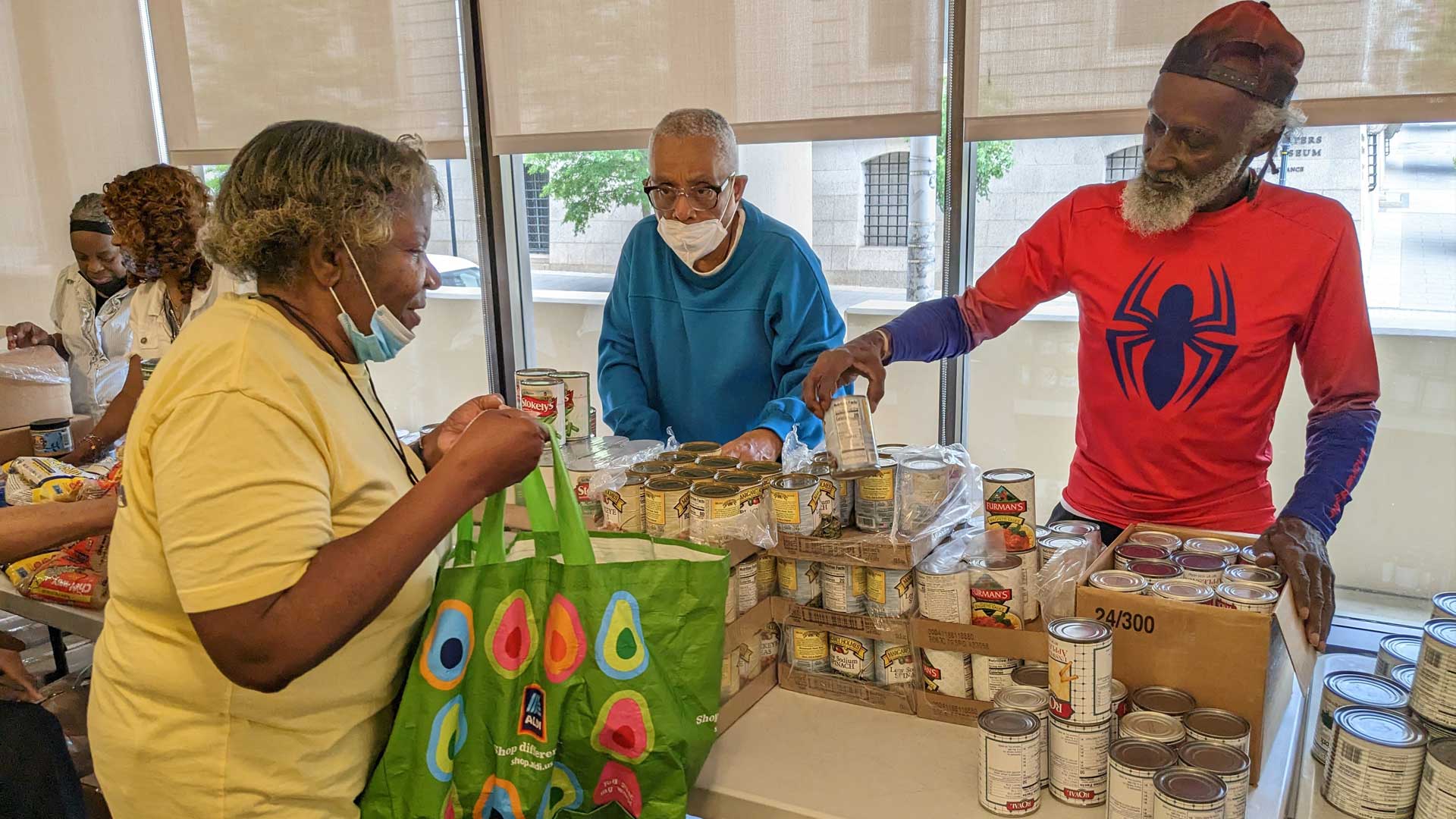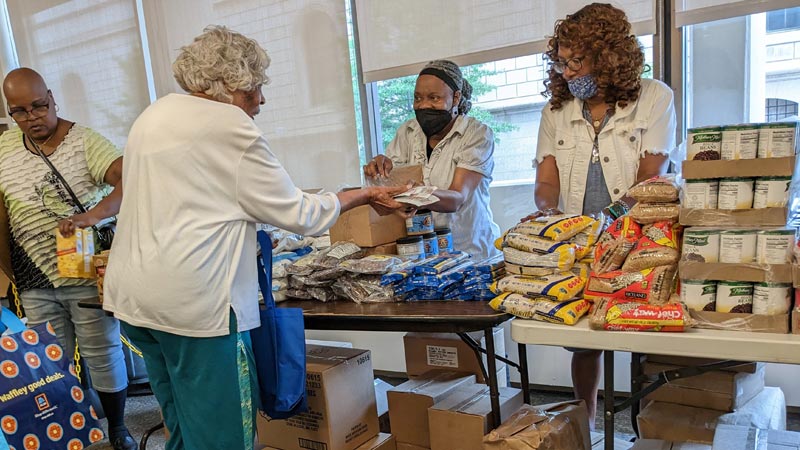Increasing Prices Remain a Concern For Older Adults

Maryland consistently ranks near the top of states with the highest cost of living, already making it difficult for older adults to make ends meet. But with the current cost of groceries so high, even more of our fellow Marylanders are hurting.
According to Feeding America, the average cost of a single meal in Baltimore City is $4.43—nearly 10% higher than in 2022, and the second-highest cost in the entire state, trailing only Montgomery County’s $4.52 cost per meal.
Now imagine being an older adult, living on a fixed income, seeing daily reports about high food prices, and trying to figure out how to continue to feed yourself.
Recently, residents at Westminster House on North Charles Street shared their personal stories of dealing with hunger today.

The Best Laid Plans
Neighbors like Arthur B. feel very real frustration that no matter how much they worked or planned for retirement, there are some things that are just out of their control.
“I don’t like to admit it, but I need this food. I worked, and worked, and worked—hard work, you know, physical labor work. But now, I’m too old to do that, and now that I’m here, I’m stuck,” he said at a Pantry on the Go event in July.
“I’d rather pay for things myself, but it’s just too hard. My money is fixed, and just a few years ago seemed like it would last, but it just isn’t – how come their prices keep going up, but my money stays the same?” he continued.
Resident Josephine L. shares some of Arthur’s feelings on feeling helpless.
“This was supposed to be my time, but the last few years messed me up good. It messed up my family, my friends, and my finances. It should have been enough money, but with the stock market doing what it did, and prices going crazy, I just can’t do it myself,” she said.
But Josephine is encouraged by the assistance she receives at Westminster House.
“I’m so happy to have this available to me, hot meals, fresh fruits, and good people around me—almost gives me hope again. Maybe I will get by…”
And it’s not just Arthur, Josephine, and other Baltimore City residents who are forced to deal with these challenges (and emotions). Statewide, the average cost per meal has risen by 9%—from $3.56 to $3.90 since 2022.

Which Price is Higher—The Chicken or the Egg?
As we age, we tend to encounter health issues, making the nutritional quality of the food we consume even more important. And health concerns like heart disease, high blood pressure, and diabetes can sometimes be managed with proper nutrition—yet these healthier fresh foods generally cost more than the more easily affordable (and accessible) processed ones.
And Regina B., who calls Westminster House home, is dealing with the double whammy of diabetes and inflated prices.
“I’m a diabetic, so I try to watch what I eat. When I can get a ride to the store, it seems like everything went up—eggs are like $2 more per carton, and the chicken that used to be $2-3 per pound is almost double, too much for me to afford, so I get a smaller package now,” she said.
But she remains positive, adding “Having this food available to us right in our building is a blessing, and it is necessary for us!”
SNAP Judgements Have Long Term Effects
Once known as food stamps, today’s Supplemental Nutrition Assistance Program (SNAP) is a vital lifeline for nearly 800,000 individuals in Maryland who struggle to afford their bills and nutritious food.
And during the pandemic, extended SNAP benefits made a tangible difference in the lives of many of our neighbors. But now, those additional benefits have been eliminated, and recent data does not bode well for Marylanders who relied on them.
According to the Urban Institute, there is a widening gap between the average SNAP benefit per meal ($2.73) vs the actual average meal cost in Maryland ($3.19).
For resident Elizabeth J., the loss of some of these benefits that were available dramatically raises the level of importance for the regular food distribution events at Westminster House.
“When the extra food stamps stopped, I just couldn’t afford some of the basics anymore. So having Miss Lavelle and the people here who help give out the food is just, well, I’m sorry I am breaking up, but it makes me emotional that people still care about us here,” she said.
“This was supposed to be my time, but the last few years messed me up good. It messed up my family, my friends, and my finances. It should have been enough money, but with the stock market doing what it did, and prices going crazy, I just can’t do it myself.”
New Ways to Help our Older Adults
Since November 2022, Resident Services Coordinator Lavelle Webb has been focusing on the well-being of the residents at Westminster House, and knows how important nutritious food is to people, especially older adults during a time of inflation.
“Our relationship with the Maryland Food Bank means so much to the residents who live here at Westminster House. As you can imagine, most people here have to be careful about money, so when prices go up, it’s a real issue,” said Lavelle.
In addition to the bi-weekly food distributions that feature a mix of fresh produce and shelf stable goods delivered from MFB’s Halethorpe warehouse, Westminster House also has a hot meal program called “Eat Together,” to encourage residents to literally eat together, which supports both their physical and mental health.
“We do a lot of things here, but with these two food programs, our residents are supported physically and emotionally, and I can’t tell you how thankful we are for the Maryland Food Bank’s partnership,” said Lavelle.
While we’re here for every Marylander who struggles to make ends meet, older adults are part of a special group of neighbors facing challenges unique to their circumstances. Other examples of our “Priority Populations” include children, Communities of Color, and members of the military.
We recognize the additional burdens that higher food prices can put on these particular neighbors, so we’ll continue to pair our knowledge of the local communities we serve with tools like the Maryland Hunger Map to help provide relief to the people who need it most, in the areas where they live and work.
Get updates on our progress in the fight against hunger
Want to see how your involvement directly impacts the well-being of your neighbors in need? Get the latest news sent to your inbox.







